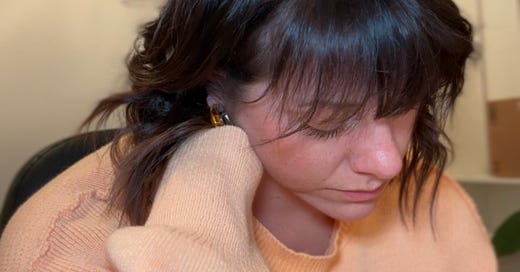Have you ever caught yourself hesitating to fully commit to something new because a protective voice inside whispers, "Is this even worth it?" That's exactly what happened to me this week as I was bringing my books into my new studio space. After two years in storage, I found myself questioning whether I should unpack them at all – what if I just have to move them again?
Then I remembered: I signed a year lease. This space is mine. This moment is real.
That tiny hesitation sparked today's podcast episode about what I'm calling "the trauma paradox" – how we can simultaneously protect ourselves from future pain while still creating a meaningful life right now.
The Trauma Paradox Explained
When we experience trauma – whether divorce, loss, or any major disruption – our brain creates protective mechanisms to help us survive. It's actually remarkable how we're wired for self-preservation.
What's fascinating is the research on post-traumatic growth. According to Psychology Today, greater PTSD symptoms often correlate with greater potential for post-traumatic growth – which manifests as developing a new philosophy of life, deeper relationships, and a stronger sense of self. The intensity of our struggle can become fuel for transformation.
After my divorce, I kept my book project mostly to myself for months, reluctant to announce it publicly until I had the physical copy in my hands. Part of me was scared to believe it was really happening because I'd experienced the pain of having my future plans suddenly disappear. That protective mechanism whispered, "Don't get too attached to future plans because they might not happen."
Yet simultaneously, I was actively creating something new. I was writing, working with my publisher, moving forward despite that protective voice urging caution.
When Protection Becomes a Prison
Research has shown that while avoidance feels protective in the short term, individuals who heavily rely on avoidance as a coping strategy are actually at higher risk of increased PTSD symptoms over time. What initially protects us can eventually imprison us.
I felt this viscerally when bringing books to my studio. That hesitation – "Is this even worth it?" – was my protection mechanism trying to shield me from potential future disappointment. But if I had listened completely, I would have kept everything in boxes, never fully settling in, always living with one foot out the door.
This happened in my marriage too. Looking back, I can see there were red flags, but I kept thinking if I just worked harder, things would improve. That avoidance was trying to protect me, but ultimately it kept me stuck in an unhealthy situation longer than necessary.
The protection paradox is that the very behaviors that help us survive trauma can prevent us from thriving afterward. The walls we build to keep out pain also keep out joy, connection, and growth.
Finding Glimmers Within the Paradox
This is where my practice of finding glimmers becomes essential. When we're in the aftermath of trauma, we often can't see the big picture. The overall situation might still be painful or uncertain. But glimmers – those tiny moments of joy or calm – give us micro-moments of okayness that sustain us until larger healing happens.
I love what Teal Swan writes about this paradox: "Trauma can seriously prevent what you really want. But also, seemingly paradoxically, it can seriously custom forge you for what you really want." The very experiences that cause us pain can shape us in ways that ultimately help us become who we're meant to be.
For me, the trauma of divorce prevented what I thought I wanted – marriage, family, the life I had planned. But it also forged me into someone who could write "Daily Sparkles," who could connect with others about finding light in darkness, who could build a community around healing and growth.
Finding glimmers doesn't deny the pain – it exists alongside it. This is the essence of "the and" that I talk about so often. You can be grieving AND experiencing moments of joy. You can be healing AND creating something new.
Practical Approaches to Living the Paradox
So how do we actually live in this paradox? How do we honor our need for protection while still moving forward?
Research on paradoxical therapy approaches offers insight. These approaches help people step back from behaviors, gain control, and see situations from new perspectives. The key is developing awareness of our protective patterns without judgment, then making conscious choices about whether those patterns are still serving us.
Here are three practical strategies that have helped me:
Practice recognizing when protection is helping versus hindering. Protection is helpful when it keeps us from rushing into situations we're truly not ready for. It becomes hindering when it keeps us stuck in patterns of avoidance long after the actual danger has passed.
Take small actions despite uncertainty. When I signed the lease for my studio, I didn't know for sure it was the "right" decision. I still had fears and doubts. But I decided to act anyway, knowing I could handle whatever came next. Each small action builds confidence in your ability to handle change.
Find daily practices that honor both healing and forward movement. For me, journaling is essential – it gives space to acknowledge fears and pain while articulating hopes and plans. Movement and exercise have also been vital, helping me feel present in my body and capable of taking action.
Whatever practices you choose, approach them with awareness of the paradox. You're not trying to rush past healing or deny protective instincts – you're simply creating space for growth alongside them.
Embracing "The And"
Living in the paradox means holding two seemingly contradictory truths simultaneously: caution born from experience AND courage to create anyway. It's not about choosing between healing and moving forward – it's about doing both, honoring both, embracing both.
You don't have to feel good to see the good. You don't have to be completely healed to start creating. You don't have to have everything figured out to take the next step.
Just like finding glimmers, living in this paradox is about expanding your capacity to hold complexity. Life isn't either/or – it's both/and. You can be scared AND brave. You can be healing AND creating. You can be protective AND open.
The more we practice holding these paradoxes, the more freedom we find. Because we're no longer waiting for perfect conditions before we allow ourselves to truly live.
Journal Prompts for Exploring Your Own Paradox
What protective patterns have I developed from past experiences, and how might they be both helping and hindering me now?
When was a recent moment where I felt truly alive? What was I doing, and was I in a state of reflection or action?
What's one small step I could take today that acknowledges my fears but doesn't let them make my decisions?
In what ways has my trauma or hardship "custom forged" me for what I truly want or who I'm becoming?
Where in my life am I waiting to feel "ready" or "healed enough" before taking action, and what might happen if I act anyway?
Today's Glimmers
Curling my hair and having it come out exactly how I wanted
Watching old family home videos and seeing all the moments I was being loved without even realizing it
Unpacking my special books that have been in storage – my first edition Shakespeare collection, first edition Harry Potter and the Philosopher's Stone, The Story of the Trapp Family Singers, and my grandmother's handwritten date book
Watching my dog Theo lying in the grass, taking in the world, simply being a dog
Getting in my car and realizing past-me had already filled the gas tank… a gift to present-me!
Research References:
The Paradox of Trauma - Psychology Today
The Trauma Paradox - Psychology Today
The Trauma Healing Paradox - Teal Swan
Paradoxical Therapy: Pros, Cons, and Techniques - Healthline
My book "Daily Sparkles: Illuminate Your Life With 1000 Glimmers" is the perfect gift for anyone who needs a little light in their life (Mother's Day is coming up!)
If you're looking for community, join my Substack for $6/month. You'll get access to twice-weekly live sessions – our co-working hangouts and Main Character Moments workshops – plus an extra podcast episode each week.
What's your experience with this paradox of protection and creation? I'd love to hear your thoughts in the comments.
Until next time, remember that healing and creating can happen simultaneously. You don't have to choose. You can embrace the paradox and find your power there.
Keep seeking the sparkles, Emma













Share this post